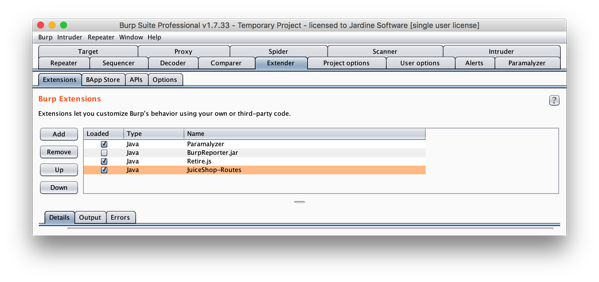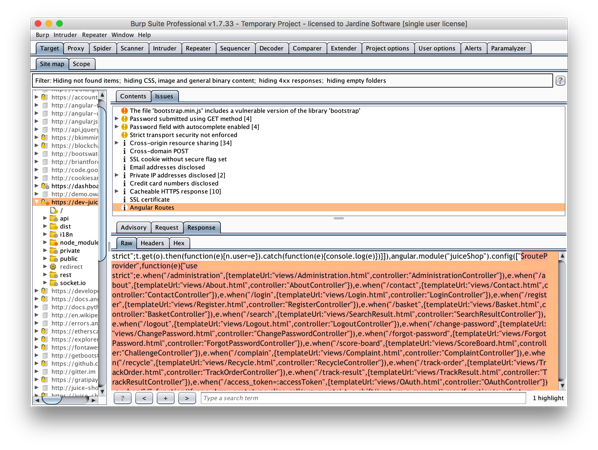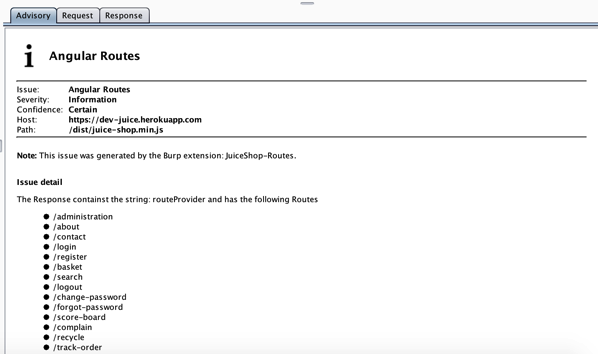When it comes to testing for security within our web applications, we often look to creating simple tools to help speed things up. They also help provide a consistent way to help identify known patterns. For those that haven’t been following, I have been doing a few posts about getting the OWASP Juice Shop application up and running. In this post, I want to introduce a simple burp extension I created to help with a few of the challenges presented in the OWASP Juice Shop.
The Challenge
The OWASP Juice Shop has multiple challenges built into it to help guide the user along in finding web applications. The app is written as a single page app (SPA) and is a little different than your traditional applications. Rather than make a full page request for everything you click, instead the application just makes API calls. In short, the entire UI is returned on the first load of the application.
There are multiple challenges within the Juice Shop that require the user to access specific URLs that are not available via a menu or link. For example (and I don’t want to directly give away answers to the challenge here), imaging visiting the contact screen. If you click the menu item for contact us, it will update the URL in the address bar to be like /#/contact. So I don’t have to actually click a link to access the contact us page, I could just update that URL directly in the address bar.
Finding the Routes
So how do you find the URLs that are available to access? There are multiple ways of doing this. First, of course, you could try to just fuzz them. This is good if the URLs are not available anywhere for us to find. Fortunately, this Angular application embeds the different routes within the client-side code. It uses a RouteProvider object to do this.
With a little digging, you can find this information in the /dist/juice-shop.min.js file. This is a pretty large file and looking through it can be a little tough. Searching for RouteProvider will bring you to the route definitions.
A Burp Extension
As a professional web app tester, I spend a lot of time using Burp Suite as my web proxy. It allows me to easily view and intercept all the traffic my browser sends back and forth to the server. Another cool feature is it allows building your own extensions to solve just this type of problem. Of course, you probably wouldn’t just create an extension for this one piece or a specific app. Instead, the hope would be that it would become helpful for other applications that use angular’s route provider object. This way, when I go to test other sites, I may get this information right there in my scanner results.
I built a quick little burp extension that looks for the routeProvider object and then, if found, pulls out each route defined. The code can be found at https://github.com/jamesjardine/juiceshoproutes. The code that performs all the tasks are in the BurpExtender.java file.
Once the extension is built into a JAR file it can be added into Burp. Note that this only works for Burp Pro because it uses the passive scanner. To install it, just navigate to the “Extender” tab and click the Add button. Then select the Jar file you created:

Here is a quick run down of what it does:
- Looks to see if the response from the server contains the phrase $routeProvider. If it finds this phrase it then gets the start offset and the end of the object by identifying the next ] character.
- It then loops through the specific body text looking for a match to e.when. This basically defines when the URL matches X, load a specific template.
- Each route that is identified is then displayed in an unordered list.
- When you visit the Target Tab and select your site, click on the Issues tab to look for Angular Routes.
This is just a quick example of how building custom burp extensions can help increase your efficiency or help provide some additional coverage for known patterns within applications.
————–POTENTIAL SPOILER INFO BELOW ——————–
IF YOU ARE WANTING TO TRY THIS OUT WITHOUT SEEING THE RESPONSE FIRST STOP READING HERE!!!
There is no interaction needed to trigger this scan except for just visiting the initial page of the Juice Shop site. The Issues tase will look like:

If you look at the response, you will see the following image:

In the above image you can see the highlighted area showing where the RouteProvder routes are defined. In the following image, you can see the advisory screen which indicates the formatted list of routes that are available:

Leave a Reply
You must be logged in to post a comment.